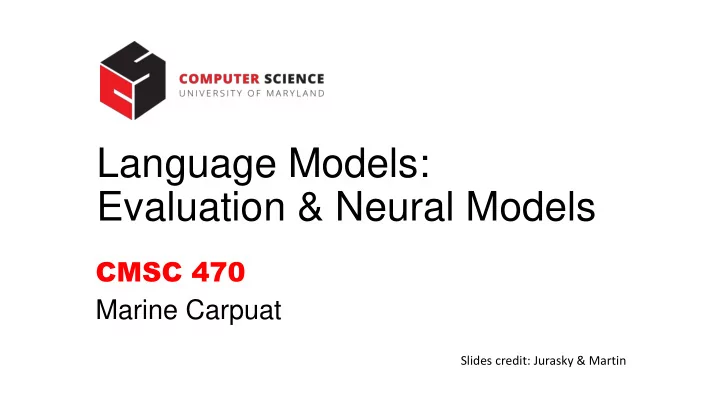

Language Models: Evaluation & Neural Models CMSC 470 Marine Carpuat Slides credit: Jurasky & Martin
Language Models What you should know • What is a language model • A probability model that assigns probabilities to sequences of words • Can be used to score or generate sequences • N-gram language models • How they are defined, and what approximations are made in this definition (the Markov Assumption) • How they are estimated from data: count and normalize • But we need specific techniques to deal with zeros • word sequences unseen in training: add 1 smoothing, backoff • word types unseen in training: open vocabulary models with UNK token
Pros and cons of n-gram models • Really easy to build, can train on billions and billions of words • Smoothing helps generalize to new data • Only work well for word prediction if the test corpus looks like the training corpus • Only capture short distance context
Evaluating Language Models
Evaluation: How good is our model? • Does our language model prefer good sentences to bad ones? • Assign higher probability to “real” or “frequently observed” sentences • Than “ungrammatical” or “rarely observed” sentences? • Extrinsic vs intrinsic evaluation
An intrinsic evaluation metric for language models: Perplexity The best language model is one that best predicts an unseen test set • Gives the highest P(sentence) - 1 = PP ( W ) P ( w 1 w 2 ... w N ) N Perplexity is the inverse probability of the test set, normalized by the number of words: 1 = N P ( w 1 w 2 ... w N ) Chain rule: For bigrams: Minimizing perplexity is the same as maximizing probability
Interpreting perplexity as a branching factor • Let’s suppose a sentence consisting of random digits • What is the perplexity of this sentence according to a model that assign P=1/10 to each digit? The Branching factor of a language is the number of possible next words that can follow any word. We can think of perplexity as the weighted average branching factor of a language.
Lower perplexity = better model • Comparing models on data from the Wall Street Journal • Training: 38 million words, test: 1.5 million words N-gram Unigram Bigram Trigram Order Perplexity 962 170 109
The perils of overfitting • N-grams only work well for word prediction if the test corpus looks like the training corpus • In real life, it often doesn’t! • We need to train robust models that generalize • Smoothing is important • Choose n carefully
A Neural Network-based Language Model
Toward a Neural Language Model Figures by Philipp Koehn (JHU)
Representing Words • “one hot vector” dog = [ 0, 0, 0, 0, 1, 0, 0, 0 …] cat = [ 0, 0, 0, 0, 0, 0, 1, 0 …] eat = [ 0, 1, 0, 0, 0, 0, 0, 0 …] • That’s a large vector! practical solutions: • limit to most frequent words (e.g., top 20000) • cluster words into classes • break up rare words into subword units
Language Modeling with Feedforward Neural Networks Map each word into a lower-dimensional real-valued space using shared weight matrix Embedding layer Bengio et al. 2003
Example: Prediction with a Feedforward LM
Example: Prediction with a Feedforward LM Note: bias omitted in figure
Estimating Model Parameters • Intuition: a model is good if it gives high probability to existing word sequences • Training examples: • sequences of words in the language of interest • Error/loss: negative log likelihood • At the corpus level error 𝜇 = − σ 𝐹 in corpus log 𝑄 λ (𝐹) • At the word level error 𝜇 = − log 𝑄 λ (𝑓 𝑢 |𝑓 1 … 𝑓 𝑢−1 )
This is the same loss as the one we saw earlier for Multiclass Logistic Regression • Loss function for a single example 1{ } is an indicator function that evaluates to 1 if the condition in the brackets is true, and to 0 otherwise
Example: Parameter Estimation Loss function at each position t Parameter update rule
Word Embeddings: a useful by-product of neural LMs • Words that occurs in similar contexts tend to have similar embeddings • Embeddings capture many usage regularities • Useful features for many NLP tasks
Word Embeddings
Word Embeddings
Word Embeddings Capture Useful Regularities Morpho-Syntactic Semantic • Word similarity/relatedness • Adjectives: base form vs. comparative • Nouns: singular vs. plural • Semantic relations • Verbs: present tense vs. past tense • But tends to fail at distinguishing [Mikolov et al. 2013] • Synonyms vs. antonyms • Multiple senses of a word
Language Modeling with Feedforward Neural Networks Bengio et al. 2003
Count-based n-gram models vs. feedforward neural networks • Pros of feedforward neural LM • Word embeddings capture generalizations across word typesq • Cons of feedforward neural LM • Closed vocabulary • Training/testing is more computationally expensive • Weaknesses of both types of model • Only work well for word prediction if the test corpus looks like the training corpus • Only capture short distance context
Language Models What you should know • What is a language model • N-gram language models • Evaluating language models with perplexity • Feedforward neural language models • Use a neural network as a probabilistic classifier to compute probability of the next word given the previous n words • Trained like any neural network by backpropagation • Learn word embeddings in the process of language modeling • Strengths and weaknesses of n-gram and neural language models
Recommend
More recommend